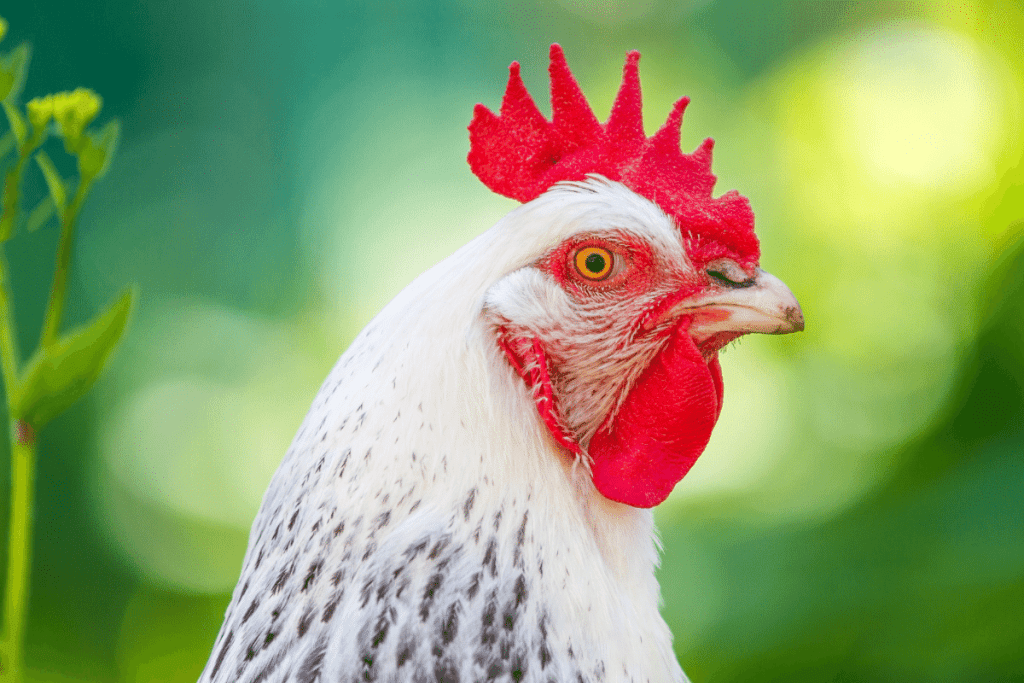If you’ve watched a chicken walk, you may have noticed they bob their heads like pigeons.
Even though it looks like they are moving their heads up and down, they are not.
As they take a step, they thrust their head forward and maintain their position as their body catches up.
It leads many of us to the bigger question of why chickens bob their heads.
Because chickens cannot move their eyes within their eye sockets like humans, they have to bob their entire heads to change their field of vision. Chickens can keep their head still while their body is moving, known as a gyroscopic effect, which enables them to stabilize their vision.
This is part of the vestibulo-ocular reflex, which is a reflex where the head and eyes remain fixed on a point, as long doing so isn’t too difficult for the body.
The ability to maintain their field of vision is an asset to chickens as prey and predator.
Keep reading for more information on chickens bobbing their heads and how their vision works!

Table of Contents
ToggleHow Does The Vestibulo-Ocular Reflex Work In Chickens?
Humans’ vestibulo-ocular reflex causes us to move our eyes in the opposite direction of our head movement to stabilize the images on our retinas.
These are jerky movements from one place to the other.
These individual movements are called saccades, and at the very end of a saccade, the eye stops moving for a moment.
This brief pause is long enough to stabilize the image we are looking at on our retina, so our brains can process it like moving a camera, stopping, and taking a picture.
Chickens’ vision is stabilized by keeping their eyes and head fixated while their body moves.
They aren’t bobbing their heads; it just looks like it to us.
Chickens thrust their heads forward, then hold their head still, and vision fixated as their body catches up.
Most chicken saccades occur in the head thrust phase of the movement.
It makes it look like their head is moving back and forth when, in reality, it is moving forward and holding still.
The motion may help their depth perception.
For more information on eye movement in chickens, visit the Journal of Experimental Biology.
How Do Chickens See?
Like most prey animals, chickens’ eyes are on either side of their head.
This gives them a much greater range of vision, which is important to be able to see predators.
They have about a 300° degree field of vision versus our 200° degrees.
This creates monocular vision, which means only one eye sees an object at a time.
This is why you’ll see a chicken look at something, then turn its head and look at it again with another eye.
They are, however, able to see about 30 degrees° in front of their beak with both eyes, which enables them to see what they are pecking at, which I am sure you’ll agree is important.
Humans see about 120° degrees in front of ourselves because our eyes face forward.
Being able to see the same object with both eyes is called binocular vision.
A small amount of binocular vision enables a chicken to see what it is foraging.
Chickens can use each eye independently to keep an eye out, so to speak, for predators or prey while they are happily pecking away.
Why Do Chickens Stabilize Their Heads?
By keeping their head and eyes still, they can keep their vision stable while moving.
Seeing while they are moving enables them to see not only a threat in their environment but also their next tasty treat.
Why Are Chickens’ Movements So Jerky?
Chickens’ head movements are jerky because they are using rapid head movement to compensate for their eyes not being able to move very much.
Their light bones and long, flexible necks enable them to move their heads quickly.
They look at an object with each eye to gain depth perception, just like we do, but they have to turn their heads.
This makes it look like they are jerking their heads back and forth.
Do Chickens See Better Than Humans?
Chickens see the same way we do but are better at many aspects of vision, including the range of vision and motion detection.
Another interesting fact is chickens are tetrachromatic, which means they have an additional cone to the usual three for red, yellow, and blue and can see in the ultraviolet range.
This ability enables them to see a wider range of colors than we see.
Although we aren’t sure what function this has for birds, it may play a part in choosing a suitable mate.
They have a double cone retina structure which helps them see movement better than humans.
It is also a characteristic of predatory birds, such as hawks.
These traits help protect chickens from predators while also making them excellent hunters.
One unhelpful characteristic is not being able to see in the dark.
Why Do Some Birds Bob Their Heads?
Several bird species bob their heads; many are ground-feeding birds such as quail, turkey, and pigeons.
They need to be able to see around them as much as possible to avoid getting eaten.
They fix their eyes on a stationary object and keep their vision steady, so their surroundings do not blur as they move.
When something moves too fast to process, the brain blurs the image.
This would put prey animals at a definite disadvantage.
Birds are known to take small steps, hop or have a wider, more stable stance, and do not bob their heads, leading scientists to think there is a balance component too.
Read next: Can chickens eat chocolate?
How useful was this post?
Click on a star to rate it!
We are sorry that this post was not useful for you!
Let us improve this post!
Tell us how we can improve this post?
